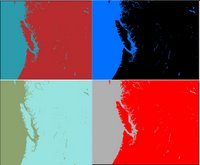The global trend in climate warming is affecting a wide range of species and ecosystems, and in areas like the northern sub-boreal, boreal and subarctic ecosystems, the warming effect is stronger [1-4].
Climatic changes will have an economic impact due to increased severity of fire, insect and disease epidemics, and drought-related dieback of forest trees [1], nonetheless some countries might even experience a higher productivity in relation to the warmer climate.
It is not clearly understood how ecosystems would respond to shifts in climate [2] since different populations (i.e.: trees) may respond differently to climate changes [3].
It is almost impossible to consider all the processes involved when modeling impacts of climate change on a large geographical scale, but in a more practical way climate modeling can help for ecosystem restoration, conservation planning, plantation forestry or genetic resource management [2].
Changes in terrestrial net primary production (NPP) integrate climatic, ecological, geochemical, and human influences on the biosphere, but a globally comprehensive analysis of the impacts of climatic changes on NPP is lacking [4]. Since the early 1980s meteorological sensors mounted on satellites have provided data to remotely estimate NPP [4].
Modeling climate data for resource management requires matching the spatial scale of the climate and the resource database [5].
Newly developed programs (ClimateBC and ClimatePP) provide climate data for specific locations based on latitude, longitude and elevation using a scale-free mathematical climate model on top of existing medium resolution climate data, such as the PRISM datasets [5-8].
My principal objective is to produce predictions of current and future forest growth for British Columbia (BC) and Alberta (AB) in order to develop a better understanding of the seasonal and inter-annual climatic effects on long term forest productivity.
Previous studies on long term forest productivity diverged in their conclusion; this controversial outcome indicates the need for more studies on the topic [9, 10].




